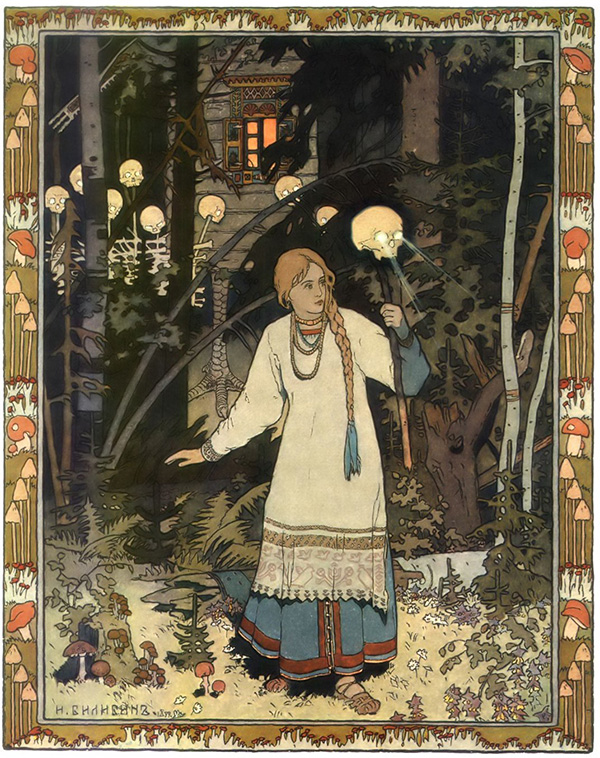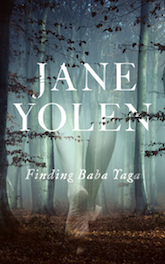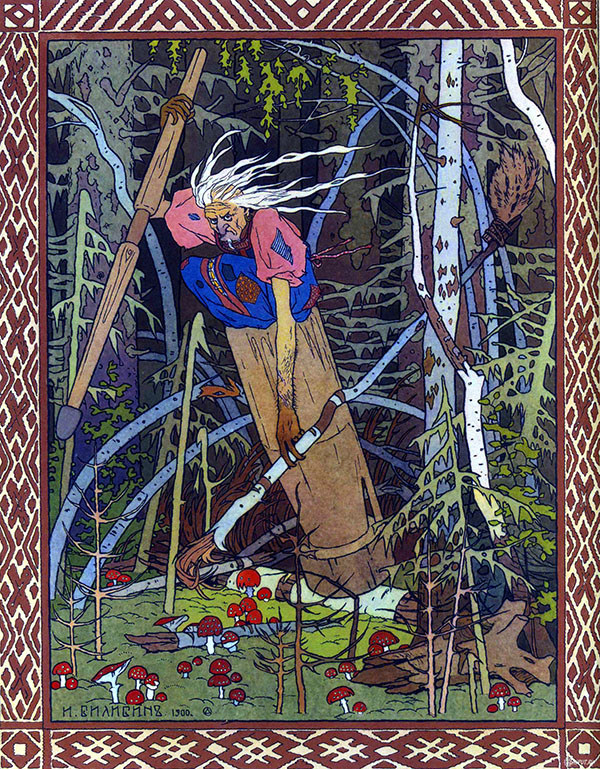Despite her appearances in numerous folktales, Baba-Yaga is one of the few creatures of fairy tale that I first encountered strictly through paintings and images, rather than through text or animated cartoon. In part, this is because she was left out of my various collections of western fairy tales, especially since it was years before I encountered the Andrew Lang collections. The ones I had largely focused on English, French, German, Norwegian and Italian fairy tales, with the occasional Spanish or Arabic (or probably faked Arabic, in the case of Aladdin and Ali Baba and the Forty Thieves) story thrown in. She is, after all, from Russia, and although the occasional Russian or Slavic element crept into my collections, these appearances were rare.
But I did see the pictures: horrific images of a person more skeleton than person, really, reaching out with clawed hands towards terrified children; tiny bizarre houses resting on—could those be bird feet? Chicken feet?—hidden deep in the woods; fiercely ugly old women with long noses using skulls as lanterns.
They were powerful. They were mesmerizing.
Clearly, they had a story.
(And may I just say, while I perfectly buy the theory that the “chicken legs” on Baba Yaga’s house were inspired not by actual chickens, but by stilt houses whose stilts do, at a distance, look like bird legs—birds that could, I guess, be chickens—I prefer to think that Baba Yaga is just awesome enough to use actual chicken legs, not “at a distance, these could be chicken legs,” for her house. Especially since that explains just how her house can walk around.)
But it was years before I found any of the Baba Yaga stories, even though two of them are relatively well known in English: Vasilissa the Beautiful or Vasilissa the Fair, a Cinderella variant where Cinderella interrupts her social climbing to visit a haunted house, and The Death of Koshchei the Deathless, also known as Maria Morevna, with the titles slightly varying depending upon the translator.
Both tales were translated into English in the mid-19th century by William Ralston Sheddon-Ralston (1828-1889), who understandably chose to go by the name W.R.S. Ralston in his scholarly publications, and reprinted in his scholarly work Russian Fairy Tales: A Choice Collection of Muscovite Folklore (1873).
Intended for a scholarly British audience, Russian Fairy Tales mingles the tales with introductions, Sheddon-Ralston’s commentary on Russian folklore and society, other scholar’s commentaries on Russian folklore and society, comparisons to folklore from other countries, and extensive footnotes. These are often somewhat condescending, if not worse, introductions, commentary, comparisons, and footnotes, with at least one comment making me wonder why Sheddon-Ralston studied fairy tales at all:
As usual, all these stories are hard to understand.
Grumble.
Still, Andrew Lang was able to dip into the collection, choosing to reprint its version of The Death of Koschei the Deathless in The Red Fairy Book (1890), introducing a version of Baba Yaga to many young English readers. A rather edited version of Baba Yaga, I might add—Lang continued to have Certain Ideas of what was and was not appropriate for young readers, whatever their thoughts on the subject—and one that left Baba Yaga’s appearance rather vague. Even the chicken legs supporting the house were left out—though Lang did keep the detail of Baba Yaga’s love of decorating her home with human heads.
Lang easily could have taken still more stories from Sheddon-Ralston’s collection, which even included a small section dedicated to Baba Yaga, described by the scholar as a “female fiend whose name has given rise to much philological discussion of a somewhat unsatisfactory nature.” (This sort of thing, which is not one of the comments I’m calling condescending, for the record, is all over the book, and probably helps explain just why this book failed to achieve the popularity of, say, the typical translation of Grimm stories into English.) This is the section featuring his translation of Vasilissa the Fair, but it also includes different descriptions of Baba Yaga’s house—the familiar, shifting, moving one on chicken legs, and the mansion surrounded by a fence of bones—along with quick references to various tales of how the Baba Yaga can be tricked, and how the Baba Yaga happily consumes human flesh. And, I must note, then very thriftily turns the leftover bones into building materials. All stuff that Lang could have used, but may have found a bit too horrific for younger readers.
This section also includes a tale called The Baba Yaga, which turns out to be more the story of a girl whose father marries again (which may sound familiar) and who finds out that her stepmother is the sister of a Baba Yaga (which may sound a little less familiar). Luckily, another older woman is able to give the girl advice about how to befriend the Baba Yaga’s servants and avoid the other dangers of the house. The servants are delighted to be given gifts at last (and the talking doors are happy to finally be oiled), and thus help out the girl. Sheddon-Ralston takes this tale as an example of Baba Yaga’s evils: I take it as a pointed lesson from the original storyteller about the importance of treating servants and other employees well. If you do, you can turn as many young girls into breakfast as you want.
If you don’t—well.
Prepare for a very aggravating day.
Without breakfast.
Interestingly enough, Sheddon-Ralston fails to comment on some other tidbits he collected here and there about Baba Yaga—for instance, in The Blind Man and the Cripple, a tale notably not included in the Baba Yaga section, but in the fourth section on Magic and Witchcraft, where a Baba Yaga begins to suck on the breasts of a woman, slowly sucking away her health as well. The two disabled men she lives with manage to capture the Baba Yaga, forcing her to take them to a fountain filled with healing water, which cures their disabilities.
And then the two men kill the Baba Yaga and head out to hunt down the other evil doer in the tale.
Quite a bit seems to be going on here, what with that hint of a poly relationship (the woman does end up marrying one of the men by the end of the tale) and the Baba Yaga’s more lesbian tendencies (something rather prudishly ignored by Sheddon-Ralston). But I find myself particularly intrigued by this portrait of an evil woman who could help cure disabilities—but won’t, unless threatened. Perhaps understandably, given that the two men, to repeat, kill her immediately after she helps heal them, but I am still intrigued by the idea that evil can heal, or at least, conceal a source of healing.
The stories were translated into English again just a few decades later by George Post Wheeler, a journalist and career diplomat with the United States Foreign Service who served various stints in St. Petersburg, Russia, between 1906-1911, in between postings to Tokyo and Rome. Despite all of this travelling, he apparently found time to learn Russian and collect fairy tales, always an interest of his. The result: Russian Wonder Tales in 1912, which included his versions of Vasilissa the Beautiful and Koshchei the Deathless.

Interestingly enough, while Sheddon-Ralston frequently chose an almost aggressively straightforward English, and used plenty of contractions and words like “granny,” Wheeler tended to use a more archaic style, with lots of “thees” and “thous” and “thys” and variant spellings for “Tsarina” and other Russian words. I’m not sure if this was because Wheeler wanted to make his stories sound more exotic to American readers, or because he felt really strongly about the need to keep the familiar second person common in English, but it can serve to make the tales feel a little more distant. At the same time, Wheeler also included—or perhaps added on his own account—details absent from the Sheddon-Ralston versions. It makes for an interesting contrast.
Baba Yaga appears in many of Wheeler’s Russian Wonder Tales, including the first, Tsar Saltan, where Baba Yaga helps the Tsarina Marfa’s jealous sisters replace the royal children first with kittens (the kittens, I’m sorry to say, get tossed into the ocean), then puppies (the puppies, I’m even sorrier to say, also get tossed into the ocean), and then a stick of wood (the stick, I’m not sorry or surprised to say, also gets tossed into the ocean), slowly turning the Tsar against the Tsarita, who is eventually locked into a chest and tossed into the ocean (if you are starting to think that this Tsar was not exactly great at coming up with ways to kill people that did not include tossing them into the ocean, you are on the right track).
After this, Baba Yaga largely disappears from the story, though the troubles of the Tsar Saltan, Tsarina Marfa and their seven sons continue until the family is finally reunited and –
tosses the jealous sisters into the ocean.
What can I say? It’s a theme.
Baba Yaga in this tale seems rather less awful than several other characters, including the jealous sisters and I suppose, technically, the ocean. After all, Baba Yaga doesn’t actually kill anyone, unless you count the kittens, puppies, and the stick of wood—all of which are really more on the evil sisters, the Tsar and the people who actually did the kitten-, puppy- and wood-tossing than on Baba Yaga. She can even, in a way, be seen as the savior of the royal children—sure, she takes them and hides them underground, but by hiding them from the rest of the characters, she ends up saving their lives.
Another Baba Yaga appearance—along with her chicken leg house—comes in Wheeler’s long, intricate tale of the Frog Tsarina. This time, Baba Yaga is a mostly beneficial (if still terrifying) witch, who helps the prince regain his wife although I MUST SAY THAT THE WIFE IN QUESTION DESERVES A BETTER HUSBAND, which makes me kinda question just whose side the Baba Yaga is on. DEFINITELY NOT THE WIFE’S. In the context of the tale, however, I think we’re supposed to be cheering for this result, and the Baba Yaga does give the couple a nice white horse, so, there’s that.
But in other tales, the Baba Yaga is a much more clear-cut figure of evil—as in, say, Maria Morevna/The Death of Koshchei the Deathless, where she tells the hero, Ivan, that he can have a magical steed if he takes care of her horses, and doesn’t lose any of them—and then proceeds to drive the horses away, so she can blame Ivan for failing to care for them. Fortunately, Ivan has previously befriended some talking animals, who help him gather the horses again (in yet another fairy tale lesson of the importance of treating lesser creatures, and specifically talking lesser creatures like talking animals, well), allowing him to trick Baba Yaga in return. And in this tale, her house is surrounded by human heads—and she continually threatens to end Ivan’s life.
She is also a fearsome creature in the long, elaborate tale of Vasilissa the Beautiful. Vasilissa, in both translations, is the daughter of a Russian merchant, whose mother dies when she is only eight. The mother leaves her with an unusual present: a little doll which can talk and eat if given a little food and water.
Shortly after this, the merchant marries again, to a widow with two ugly daughters. If this sounds a touch familiar, you will probably not be surprised to hear that Vasilissa’s new stepmother immediately puts the girl to hard labor. You may be surprised to hear that Vasilissa’s solution to this is to talk to the doll, who, as it turns out, doesn’t just chatter or offer comfortable advice, but does chores. Better, in most respects, than a fairy godmother. Especially since, as a doll, it’s tireless.
Eventually, the merchant leaves for a trip, and the widow assigns the three girls tasks of making lace, hose and yarn, with only one candle for light—a sign that she’s not particularly interested in saving their eyesight. Sure, candles are expensive, but, as the story frequently reminds us, the merchant is well off; they can presumably afford a fire in the fireplace OR three candles or even—stay with me—BOTH.
Not surprisingly, one of the stepsisters puts out the one light—and then sends Vasilissa out to fetch fire from the closest house, which turns out to be Baba Yaga’s house. And this, everyone, is why you should keep a steady supply of matches, lighters or even just plain old flint and steel in the house, just in case you happen to acquire stepsisters who think it’s a good idea to try to fetch fire from any nearby house after dark, let alone a haunted house balanced on chicken legs, which just happens to be inhabited by a witch.
Why Vasilissa agrees to this, other than “because otherwise there wouldn’t be a story,” is a real puzzle, given that the story has already established that they live relatively close to at least one village, and given that she has a magical doll capable of doing extensive housekeeping and gardening and thus can presumably kindle fire. I’m just saying, Vasilissa has other options. Instead, she heads out to the home of Baba Yaga.
Buy the Book


Finding Baba Yaga: A Short Novel in Verse
The house is terrifying. It’s not just the chicken legs (though Vasilissa really seems to have no appreciation for them) or the various supernatural horsemen, or even the use of human bones for building material, but the way the lights in the skulls (yes, skulls) turn off and on and the way that Baba Yaga in this tale turns out to be the sort of person who demands that you stay a bit and do some work for her if you want any fire. Vasilissa—understandably clutching the doll at this point—agrees.
The presence of the doll almost makes this into a competition between two magic-users, but in the end, what frees Vasilissa is her mother’s blessing—something the Baba Yaga cannot endure to have in the house. To the point where the Baba Yaga loses her temper and throws a fiery skull at Vasilissa as the girl leaves, which, frankly, tells you all you need to know about Baba Yaga right there. I mean, she could have given Vasilissa some matches, or a cake, or some cute mittens, or a map to the nearest village, or something, but no: fiery skull. Vasilissa takes this and its fire to her stepmother and stepsisters, who have been shivering for three days without light and warmth, and watches as they burn up.
Afterwards, Vasilissa heads to the nearby village, choosing to take shelter with another elderly woman—and not, noticeably enough, with any of the men who were eager to marry her earlier. Maybe they had objections to marrying anyone who carries fire around in a skull. I can see that. Eventually, she gets into weaving—with the help of the doll—which eventually brings her to the attention of the Tsar, who marries her.
So much of this—the analogies to other Cinderella tales, the way Vasilissa watches her stepmother and stepsisters die and then finds another possible mother, the way that Vasilissa uses skilled (and kinda magical) weaving to raise her social status, the way the confrontations between Vasilissa and Baba Yaga play out almost like a competition between rival magic users—fascinates me. But I think above all, I’m struck how once again, the Baba Yaga isn’t just evil—or purely evil—but rather, something or someone standing between the protagonist and something badly needed. In Vasilissa’s case, fire; in other tales, magical horses, or healing.
And—in stark contrast to the other evil doers and villains in these tales, Baba Yaga does not stand between the protagonists and happiness, but between the protagonists and objects. Nor does she, for the most part, come after the protagonists: rather, they are sent to her, or in some cases, travel to her for assistance.
It’s easy enough, of course, to imagine the obstacles in front of our own goals as evils, and natural for storytellers to imagine these evils as characters. Imagining them as elderly women crouched in chicken leg houses might be a bit more of a stretch, admittedly, but one that does make for richer stories—however terrifying the illustrations created from them.
Mari Ness currently lives rather close to a certain large replica of Hogwarts, which allows her to sample butterbeer on occasion. Her short fiction has appeared in Clarkesworld, Lightspeed, Fireside, Apex, Daily Science Fiction, Nightmare, Shimmer and assorted other publications — including Tor.com. Her poetry novella, Through Immortal Shadows Singing, was released in 2017 by Papaveria Press. You can follow her on Twitter at mari_ness.










